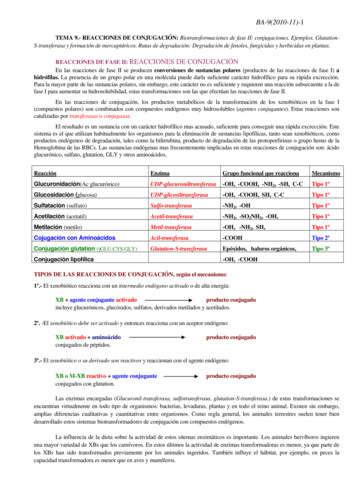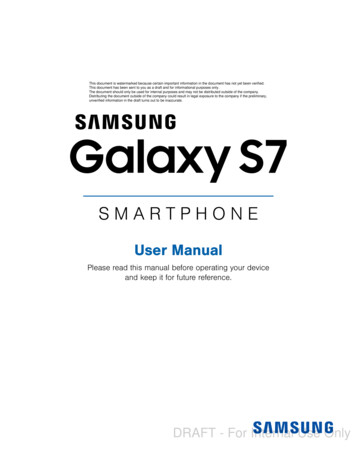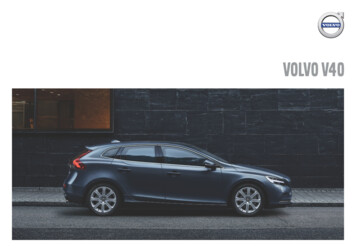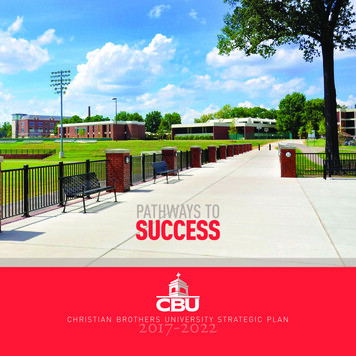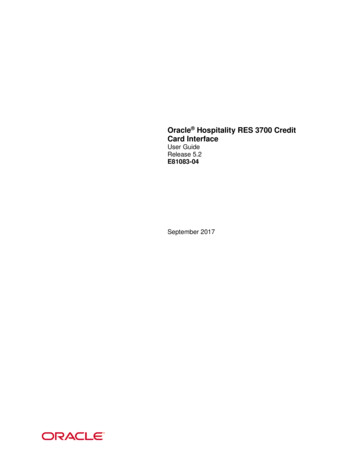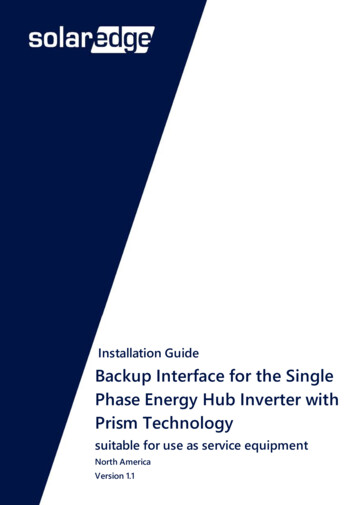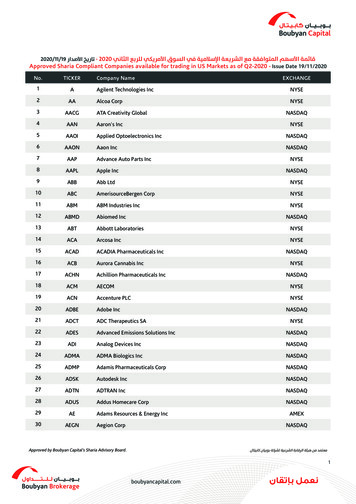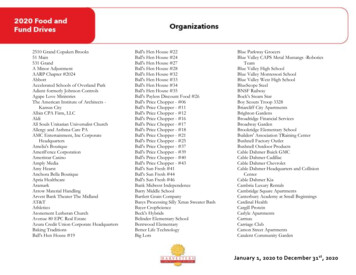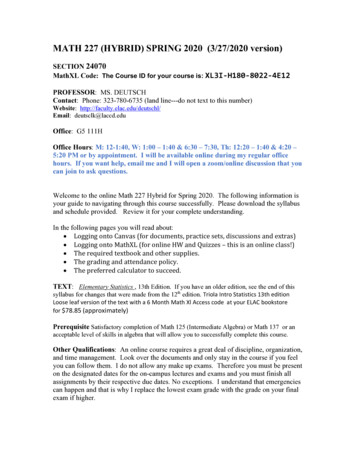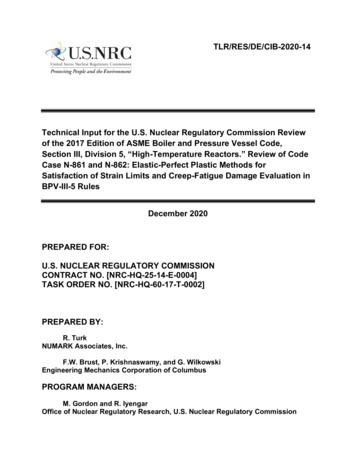
Transcription
TLR/RES/DE/CIB-2020-14Technical Input for the U.S. Nuclear Regulatory Commission Reviewof the 2017 Edition of ASME Boiler and Pressure Vessel Code,Section III, Division 5, “High-Temperature Reactors.” Review of CodeCase N-861 and N-862: Elastic-Perfect Plastic Methods forSatisfaction of Strain Limits and Creep-Fatigue Damage Evaluation inBPV-III-5 RulesDecember 2020PREPARED FOR:U.S. NUCLEAR REGULATORY COMMISSIONCONTRACT NO. [NRC-HQ-25-14-E-0004]TASK ORDER NO. [NRC-HQ-60-17-T-0002]PREPARED BY:R. TurkNUMARK Associates, Inc.F.W. Brust, P. Krishnaswamy, and G. WilkowskiEngineering Mechanics Corporation of ColumbusPROGRAM MANAGERS:M. Gordon and R. IyengarOffice of Nuclear Regulatory Research, U.S. Nuclear Regulatory Commission
DISCLAIMERThis report was prepared as an account of work sponsored by an agency of theU.S. Government. Neither the U.S. Government, nor any agency thereof, nor anyemployee, makes any warranty, expressed or implied, or assumes any legal liability orresponsibility for any third party’s use, or the results of such use, of any information,apparatus, product, or process disclosed in this publication, or represents that its use bysuch third party complies with applicable law.ii
This report does not contain or imply legally binding requirements, nor does it establishor modify any regulatory guidance or positions of the U.S. Nuclear RegulatoryCommission, and it is not binding on the Commission.iii
TABLE OF ABBREVIATIONS AND ACRONYMSADAMSAgencywide Documents Access and Management SystemANLArgonne National LaboratoryANLWRadvanced nonlight-water reactorASMEAmerican Society of Mechanical EngineersBPVboiler and pressure vesselCCelsiusEmc2Engineering Mechanics Corporation of ColumbusEPPelastic-perfectly plasticFFahrenheitFEAfinite element analysisISCCisochronous stress-strain curveNRCU.S. Nuclear Regulatory CommissionNPTNational Pipe TaperedNUMARKNUMARK Associates, Inc.ORNLOak Ridge National LaboratoryPNNLPacific Northwest National LaboratoryPVPpressure and vessel pipingRGregulatory guideSMTsimplified model testSSstainless steeliv
TABLE OF CONTENTSEXECUTIVE SUMMARY . vii1INTRODUCTION . 11.123OVERVIEW . 12.1Review Approach . 12.2Historical Basis . 32.3Review Scope . 4TECHNICAL REVIEW SYNOPSIS . 63.1Code Case N-861, “Satisfaction of Strain Limits for Division 5 Class AComponents at Elevated Temperature Service Using Elastic-Perfectly PlasticAnalysis” . 63.1.1Article 1 General Requirements . 73.1.2Article 2 Load Definition. 73.1.3Article 3 Numerical Model. 83.1.4Article 4 Requirements for Satisfaction of Strain Limits. 83.1.5Article 5 Weldments. 83.1.6Mandatory Appendix I Ratcheting Analysis . 93.24Background . Error! Bookmark not defined.Code Case N-862, “Calculation of Creep-Fatigue for Division 5 Class AComponents at Elevated Temperature Service Using Elastic-Perfectly PlasticAnalysis Section III, Division 5” . 103.2.1Article 1 General Requirements . 113.2.2Article 2 Load Definition. 113.2.3Article 3 Numerical Model. 113.2.4Article 4 Calculation of Creep Damage . 123.2.5Article 5 Calculation of Fatigue Damage . 123.2.6Article 6 Weldments. 123.2.7Mandatory Appendix I Shakedown Analysis . 13TECHNICAL REVIEW DETAIL . 154.1Code Case N-861, “Satisfaction of Strain Limits for Division 5 Class AComponents at Elevated Temperature Service Using Elastic-Perfectly PlasticAnalysis” . 154.2Overview of Code Case . 164.2.1Article 1 General Requirements . 17v
4.2.2Article 2 Load Definition. 174.2.3Article 3 Numerical Model. 174.2.4Article 4 Requirements for Satisfaction of Strain Limits. 184.2.5Article 5 Weldments. 184.2.6Mandatory Appendix I Ratcheting Analysis . 194.2.7Code Case N-861 Appendix . 204.3Code Case N-862, “Calculation of Creep-Fatigue for Division 5 Class AComponents at Elevated Temperature Service Using Elastic-Perfectly PlasticAnalysis Section III, Division 5” . 264.3.1Article 1 General Requirements . 264.3.2Article 2 Load Definition. 264.3.3Article 3 Numerical Model. 264.3.4Article 4 Calculation of Creep Damage . 274.3.5Article 5 Calculation of Fatigue Damage . 274.3.6Article 6 Weldments. 274.3.7Mandatory Appendix I Shakedown Analysis . 284.3.8Code Case N-862 Appendix . 305SUMMARY . 356REFERENCES . 36LIST OF TABLESTable 1 Review Assignments . 4LIST OF FIGURESFigure 1Figure 2Figure 3Figure 4Representative example problem (inches) (adapted from Sham et al., 2015) . 24Two-bar test case (adapted from Sham et al., 2015) . 25Representative example problem (inches) (adapted from Sham et al., 2015) . 33Representative SMT test specimen (inches) (adapted from Sham et al., 2015) . 35vi
EXECUTIVE SUMMARYThis report recommends Code Cases N-861 and N-862 for endorsement, contingent uponseveral items discussed further in the report. Use of these Code Cases is expected to lead toconservative results. Bounding theorems, mainly developed in the 1960s and 1970s, before thewidespread use of computational modeling, form the basis for the conservative nature of theseCode Cases. They represent an alternative to satisfying the strain limits (Code Case N-861)and creep-fatigue damage (Code Case N-862) using elastic-perfectly plastic finite elementmodeling where the perfectly plastic “yield” stress is defined to account for creep damage.Validation tests, with both full inelastic computational modeling and new test data, were used tovalidate the conservative nature of these Code Cases. However, Code Case N-862 may beoverly conservative in practice.vii
1INTRODUCTIONThe absence of a code of construction endorsed by the U.S. Nuclear Regulatory Commission(NRC) for nuclear reactors operating above 425 degrees Celsius (C) (800 degrees Fahrenheit(F)) is a significant obstacle for advanced nonlight-water reactor (ANLWR) designs. Review andapproval of an elevated temperature code of construction during a licensing review of a newnuclear power plant would result in substantial cost and a longer schedule.In a letter dated June 21, 2018 (Agencywide Documents Access and Management System(ADAMS) Accession No. ML18184A065), the American Society of Mechanical Engineers(ASME), based on letters from both industry consortia and individual companies interested indeveloping ANLWR designs, requested that the NRC review and endorse the 2017 Edition ofASME Boiler and Pressure Vessel (BPV) Code, Section III, “Rules for Construction of NuclearFacility Components,” Division 5, “High-Temperature Reactors” (BPV-III-5). The NRCresponded in a letter dated August 16, 2018 (ADAMS Accession No. ML18211A571), that it isinitiating efforts to endorse (with conditions, if necessary) the 2017 Edition of ASME BPV-III-5 ina new regulatory guide (RG) as one way of meeting the NRC’s regulatory requirements.To support the review and endorsement effort, the NRC requested the technical support ofNUMARK Associates, Inc. (NUMARK), and its subcontractor, Engineering MechanicsCorporation of Columbus (Emc2). This report documents NUMARK and Emc2’s technical inputfor the NRC’s review of the 2017 Edition of ASME BPV-III-5. The NRC will use it as part of theagency’s review and to support its findings in the associated RG.2OVERVIEW2.1Review ApproachThe NRC wants to ensure it performs its licensing reviews commensurate with its safety andsecurity mission and asked NUMARK to conduct its technical review in accordance with theguidance in two recent NRC examples:(1)SECY-18-0060, “Achieving Modern Risk-Informed Regulation,” dated May 23, 2018(ADAMS Package Accession No. ML18110A186), which provided the findings of theNRC Transformation Team(2)an NRC memorandum from Frederick Brown, Director, Office of New Reactors,“Expectations for New Reactor Reviews,” dated August 29, 2018 (ADAMS AccessionNo. ML18240A410)One of the memorandum’s expectations for new reactor reviews is to base the NRC’s regulatoryfindings upon the principle of “reasonable assurance of adequate protection” (of public healthand safety) but not on absolute certainty or risk avoidance. This is the legal standard for theNRC’s licensing decisions. The memorandum discusses the basis for using the terms“reasonable” and “adequate.”1
The NRC will base its endorsement of ASME BPV-III-5 in the RG on the finding that the rules inDivision 5 provide reasonable assurance of adequate protection. In accordance with thememorandum, new or novel designs or design features may need additional review orrequirements, or both. Furthermore, the NRC should consider any technical areas that ASMEBPV-III-5 does not address and that would lead to a demonstrably increased likelihood orconsequence of failure.The memorandum also mentions the consideration of margin. If the ASME BPV Code issufficiently conservative in a particular area such that it provides significant margin to relevantlimits, and sufficient data exist to support the code values, then the review in that area should bereduced. In contrast, where the code includes lesser margin and less supporting data, then thereview in that area should be increased to ensure that the staff has an adequate basis forendorsing the code and any associated conditions. In any case, the review must eitherconclude that the code provides reasonable assurance of adequate protection or that the NRCcannot endorse that section of the code, and it must provide the basis for concluding so.Similarly, the memorandum discusses making safety evaluations more succinct and includingonly the information necessary to make the NRC staff’s safety findings. Therefore, this reportprovides a concise basis for its conclusions while also maintaining clarity and completeness.This report focuses on why and how NUMARK reached its conclusions without unnecessaryhistorical or tangential information.The NRC conducted research to establish the scope of the review. This research includes ahistorical review of previous high-temperature design rules and NRC approvals. The final RG oranother accompanying NRC document will fully explain the NRC’s specific historical findingsrelevant to this report, as discussed below.This report considers the adequacy of the technical basis provided in the ASME BPV Code,including the quality and quantity of the underlying data, within the context of the selected safetymargins. It also considers the previous NRC historical findings, current operating experience,and international experience, including similar design rules, as applicable.In accordance with discussions with the former Office of New Reactors, the Office of NuclearRegulatory Research, and NUMARK’s project manager, Emc2 performed a detailed review ofthe following portions of the 2017 ASME BPV-III-5 relating to metallic materials: Nonmandatory Appendix HBB-T, “Rules for Strain, Deformation, and Fatigue Limits atElevated Temperatures”; pp. 163–251 Mandatory Appendix HBB-II, “Use of SA-533 Type B, Class 1 Plate and SA-508Grade 3, Class 1 Forgings and Their Weldments for Limited Elevated TemperatureService”; pp. 140–162 Mandatory Appendix HCB-I, “Stress Range Reduction Factor for Piping”; pp. 277–2792
Mandatory Appendix HCB-II, “Allowable Stress Values for Class B Components”;pp. 280–308 Mandatory Appendix HCB-III, “Time-Temperature Limits for Creep and Stress-RuptureEffects”; pp. 309–310 Code Case N-861, “Satisfaction of Strain Limits for Division 5 Class A Components atElevated Temperature Service Using Elastic-Perfectly Plastic Analysis”;pp. 1(N-861)–4(N-861) Code Case N-862, “Calculation of Creep-Fatigue for Division 5 Class A Components atElevated Temperature Service Using Elastic-Perfectly Plastic Analysis”;pp. 1(N-862)–4(N-862)2.2Historical BasisThe NRC researched previous high-temperature design rules and NRC approvals to establishthe scope of the review. These reviews included historical RGs, Code Cases, andpreapplication and construction permit safety evaluation reports. The NRC found that it hadaccepted the following ASME Code Cases for use, with conditions, in NRC RG 1.87, “Guidancefor Construction of Class 1 Components in Elevated-Temperature Reactors (Supplement toASME Section III Code Cases 1592, 1593, 1594, 1595, and 1596),” Revision 1, issuedJune 1975: ASME Code Case 1592, “Class 1, Components in Elevated Temperature ServiceSection Ill,” Division 1, Revision 0, dated April 29, 1974 ASME Code Case 1593, “Fabrication and Installation of Elevated TemperatureComponents Section Ill, Class 1,” Revision 0, dated November 5, 1973 ASME Code Case 1594, “Examination of Elevated Temperature Components Section Ill,Class 1,” Revision 0, dated November 5, 1973 ASME Code Case 1595, “Testing of Elevated Temperature Components Section III,Class 1,” Revision 0, dated November 5, 1973 ASME Code Case 1596, “Protection Against Overpressure or Elevated TemperatureComponents Section Ill, Class 1,” Revision 0, dated November 5, 1973This technical report uses these Code Cases as a basis for the review of the 2017 Edition ofASME BPV-III-5.3
2.3Review ScopeTable 1 lists the specific portions of the ASME BPV Code (e.g., subsection, article, Code Case)and the reviewing organization.Some assignments have additional detail related to supporting another contractor’s review. Forexample, the contractor listed for “Class A Metallic Pressure Boundary Components, ElevatedTemperature Service (HBB),” Article 2000, “Material,” is responsible for documenting theassessment for Article 2000. However, during that review the contractor may need to supportthe contractor that is responsible for reviewing HBB, Article 3000, “Design.”Similarly, contractors may need to review information within other portions of the ASME BPVCode to support the review of their assignments. For example, the contractor responsible forreviewing Article 3000 may need to review information in Article 2000. If the Article 3000contractor has concerns with Article 2000, then the two contractors should discuss them. TheArticle 3000 contractor is not responsible for any part of the documentation for Article 2000,although the Article 3000 review may impact the Article 2000 review and documentation.Table 1 Review AssignmentsGeneral Requirements, Low-Temperature Metallic Components, and SupportsASME BPV Code Section (Subsection)ReviewerGeneral Requirements, Metallic Materials (HAA)NRC StaffClass A Metallic Pressure Boundary Components, Low TemperatureNRC StaffService (HBA)Class B Metallic Pressure Boundary Components (HCA)NRC StaffClass A and Class B Metallic Supports, Low Temperature ServiceNRC Staff(HFA)Class A Metallic Core Support Structures, Low Temperature ServiceNRC Staff(HGA)Elevated Temperature Metallic ComponentsASME BPV Code Section (Subsection)ReviewerClass A Metallic Pressure Boundary Components, Elevated Temperature Service (HBB)1000 IntroductionNRC Staff2000 MaterialORNL3000 DesignPNNL4000 Fabrication and InstallationPNNL5000 ExaminationPNNL6000 TestingPNNL7000 Overpressure ProtectionNRC Staff8000 Nameplates, Stamping with the Certification Mark, and ReportsNRC StaffMandatory Appendix HBB-I-14, “Tables and Figures”ORNLMandatory Appendix HBB-II, “Use of SA-533 Type B, Class 1 PlateNUMARKand SA-508 Grade 3, Class 1 Forgings and Their Weldments forLimited Elevated Temperature Service”Nonmandatory Appendix HBB-T, “Rules for Strain, Deformation, andNUMARKFatigue Limits at Elevated Temperatures”4
ASME BPV Code Section (Subsection)ReviewerNonmandatory Appendix HBB-U, “Guidelines for Restricted MaterialORNLSpecifications to Improve Performance in Certain ServiceApplications”Nonmandatory Appendix HBB-Y, “Guidelines for Design Data NeedsNot reviewedfor New Materials”Class B Metallic Pressure Boundary Components, Elevated Temperature Service (HCB)1000 IntroductionNRC Staff2000 MaterialORNL3000 DesignPNNL4000 Fabrication and InstallationPNNL5000 ExaminationPNNL6000 TestingPNNL7000 Overpressure ProtectionNRC Staff8000 Nameplates, Stamping with the Certification Mark, and ReportsNRC StaffMandatory Appendix HCB-I, “Stress Range Reduction Factor forNUMARKPiping”Mandatory Appendix HCB-II, “Allowable Stress Values for Class BNUMARKComponents”Mandatory Appendix HCB-III, “Time-Temperature Limits for CreepNUMARKand Stress-Rupture Effects”Class A Metallic Core Support Structures, Elevated Temperature Service (HGB)1000 IntroductionNRC Staff2000 MaterialORNL3000 DesignPNNL4000 Fabrication and InstallationPNNL5000 ExaminationPNNL8000 Nameplates, Stamping with the Certification Mark, and ReportsNRC StaffMandatory Appendix HGB-I, “Rules for Strain, Deformation, andPNNLFatigue Limits at Elevated Temperatures”PNNLMandatory Appendix HGB-II, “Rules for Construction of CoreSupport Structures, Extended for Restricted Service at ElevatedTemperature, Without Explicit Consideration of Creep andStress-Rupture”Mandatory Appendix HGB-III, “Buckling and Instability”PNNLMandatory Appendix HGB-IV, “Time–Temperature Limits”PNNLGraphite and CompositesASME BPV Code Section (Subsection)ReviewerGeneral Requirements, Graphite and Composite Materials (HAB)NRC Staff1000 Introduction2000 Classification of Graphite Core Components3000 Responsibilities and Duties4000 Quality Assurance5000 Authorized Inspection7000 Reference Standards8000 Certificates and Data Reports9000 Glossary5
ASME BPV Code Section (Subsection)ReviewerMandatory Appendix HAB-I, “Certificate Holder's Data ReportNRC StaffForms, Instructions, and Application Forms for Certificates ofAuthorization”Class A Nonmetallic Core Components, Graphite Materials (HBB-T)NUMARK1000 Introduction2000 Material3000 Design4000 Fabrication and Installation5000 Examination8000 Nameplates, Stamping with the Certification Mark, andNRC StaffReportsMandatory Appendix HBB-T-I, “Graphite Material Specifications”NUMARKMandatory Appendix HBB-T-II, “Requirements for Preparation of aNUMARKMaterial Data Sheet”Mandatory Appendix HBB-T-III, “Requirements for Generation ofNUMARKDesign Data for Graphite Grades”Code CasesCode CaseASME Code Case TitleN-861“Satisfaction of Strain Limits for Division 5 Class AComponents at Elevated Temperature Service UsingElastic- Analysis”N-862“Calculation of Creep-Fatigue for Division 5 Class AComponents at Elevated Temperature Service UsingElastic-Perfectly Plastic Analysis”N-822“Application of the ASME Certification Mark”N-837“Alternative to the Registered Professional EngineerRequirements”N-852“Application of the ASME NPT StampReviewerNUMARKNUMARKNRC StaffNRC StaffNRC Staff3TECHNICAL REVIEW SYNOPSIS3.1Code Case N-861, “Satisfaction of Strain Limits for Division 5Class A Components at Elevated Temperature Service UsingElastic-Perfectly Plastic Analysis”This Code Case provides an alternative method for evaluating strain limits to satisfy compliancewith BPV-III-5, Subsection HB, Subpart B, HBB-T-1320 (“Satisfaction of Strain Limits UsingElastic Analysis”), and HBB-T-1330 (“Satisfaction of Strain Limits Using Simplified InelasticAnalysis”). This Code Case is termed a simplified method because it does not require the useof comprehensive full inelastic constitutive equations that account for both time-independentplasticity and time-dependent creep. This elastic-perfectly plastic (EPP) simplified analysismethod also demonstrates compliance with code strain and stress limits without the use ofstress classification procedures. Strain limits for Type 304H stainless steel (SS) and 316H SS,6
as approved for use in BPV-III-5, Table HBB-I-14.1(a), may be satisfied when performed inaccordance with the requirements of this Code Case. The EPP analysis is very simple to use.Code Case N-861 permits use of EPP finite element analysis (FEA) to show compliance withstrain limits and ratcheting. Bounding theorems, discussed in Section 4.2 and the Code CaseN-861 appendix in Section 4.2.7, confirm that EPP analysis will produce conservative results.Validation problems performed to date have shown Code Case N-861 always producesconservative results. This review recommends the Code Case for endorsement except for afew items discussed below.3.1.1 Article 1 General RequirementsGeneral requirements provide conservative predictions based on long-established boundingtheorems with the exception of structures where geometrical nonlinearities exist. This reviewrecommends endorsing the general requirements as written, except as noted below. Boundingtheorems ensure conservative predictions, except where nonlinearities exist, such as skeletalstructures, because bounds cannot be established.The bounding theorems, discussed in more detail in Section 4 and the N-861 Appendix Idescribed in Section 4.2.7, ensure the prediction of conservative strain limits using the EPPmethods, augmented with reduced pseudo-yield stress with guidance from MandatoryAppendix I to Code Case N-861. Verification and validation tests (analytical, numerical, andcomparison with experiments) conducted to date have shown that conservative predictionsresult except for “skeletal” structures. Skeletal structures (e.g., a bar with uniform axial loadthroughout) are precluded for use with the Code Case at present. For example, Jetter et al.(2017) investigated the “two bar” skeletal problem, conducted tests, and analyzed the testresults using Code Case N-861. The investigation obtained nonconservative results for some ofthe design space. Work is continuing on skeletal structures, but it is not yet complete (see theappendix in Section 4.2.7 for examples).This review recommends expanding and clarifying the definition of skeletal structures in thegeneral requirements of Code Case N-861. It is clear structures that experience nonlineargeometric changes cannot use the Code Case.3.1.2 Article 2 Load DefinitionThis review recommends endorsing the load definitions article. The composite load definitionsin the Code Case ensure conservative predictions of ratcheting.The load definitions comply with BPV-III-5 service load definitions. The lumping of servicecycles into composite load cycles, as in Code Case N-861, Appendix I, will always provideconservative results. The elimination of hold times in the composite cycle(s) (resulting in what istermed rapid cycles) permits practical finite element solutions within reasonable times within theEPP framework, which is the main advantage of using this Code Case.7
3.1.3 Article 3 Numerical ModelThis review recommends endorsing numerical model requirements except those for solutionaccuracy.The numerical model requirements are properly defined to include all details, including holesand fillets. Good examples for application of the Code Case, including mesh requirements,exist in Carter et al. (2005a, 2005b, 2011, 2012a, 2012b), Jetter et al. (2016, 2017), Sham et al.(2015), and Messner and Sham (2018), as well as in many other references they cite.Requirements for solution accuracy, however, are not specified. Modeler advice to ensurenumerical convergence and solution accuracy during the analysis might be considered. Forexample, elastic-plastic finite element codes typically increase the increment size automaticallybased on convergence history as the solution progresses. Therefore, care must be taken toensure that details in loading are not missed. The current requirement stating that the “modelmust also be accurate for small details” is not sufficiently specific for FEA. Recent work (Jetteret al., 2017) has also identified possible problems with convergence using EPP methods due tonumerical roundoff issues.3.1.4 Article 4 Requirements for Satisfaction of Strain LimitsThe present rules are consistent with HBB-T rules except the strains are obtained from thenumerical solution. The rules for defining the pseudo-yield stress are consistent with thebounding theorems ensuring conservatism. The iterative procedure described to determine thetarget strain is adequate and provides design safety using this Code Case.This review recommends endorsing the satisfaction of strain limits for ratcheting analysis usingthe Code Case four-step procedure in this article, as conservative predictions of ratcheting willoccur and the strain limit definitions of BPV-III-5, Subsection HB, Subpart B, are followed,subject to the following caveats. The assessment of HBB-2000 values of yield stress at hightemperature for 304 SS found that yield-stress values may be slightly nonconservative. Inaddition, the isochronous stress-strain curves (ISSCs), evaluated in the assessment ofHBB-T-1800, may be slightly nonconservative for high temperatures and long times for both304 SS and 316 SS.3.1.5 Article 5 WeldmentsThis review recommends endorsing the satisfaction of strain limits for weldments for ratchetinganalysis using the four-step procedure in this article. Additional validation cases for exampleswith weldments could be useful as this Code Case is extended to additional materials. Thestrain limit rules for welding are consistent with HBB-T rules (half the base metal limits). This isnot considered to be a safety-related issue.3.1.5.1 Weld Region Model BoundariesThis review recommends endorsing the definition of the weld region boundaries as written.Various weld configurations in BPV-III-5, HBB-4000, and corresponding reference to NB-4000are consistent with ASME BPV Code weld configuration definitions. Also, the definition of theweld region boundaries is consistent with HBB-T rules.8
3.1.5.2 RequirementsThis review recommends endorsing this article, as the Code Case rules are consistent withHBB-T-1714 requirements directly. The requirements for weld analysis of the geometry ofHBB-T-1714 are consistent for use with this Code Case and must be justified in the designreport.3.1.5.3 PropertiesThis review recommends endorsing Subparagraph 5.3 of Code Case N-861 as written becausethe thermal and physical properties of weldments and base metal are to be the same. Theseare to be used for the thermal portion of the EPP analysis for the base metal/weld combinationsin the properties in BPV-III-5, Table HBB-1-14.10. The design report should justify thesevalues.3.1.5.4 Dissimilar Metal WeldsThe review makes no recommendation, as Subarticle 5.4 is still under preparation.3.1.6 Mandatory Appendix I Ratcheting AnalysisA series of steps in Mandatory Appendix I to Code
TLR-RES/DE/CIB-2020-14, Review of the 2017 Edition of ASME BPVC, Section III, Division 5, "High Temperature Reactors." Code Cases N-861 and N-862: Elastic-Perfect Plastic Methods for Satisfaction o
